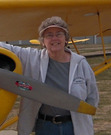Sarah Byrn Rickman's Blog, page 10
July 20, 2019
My First Stearman PT-17 Flight — June 1999
WAFS Reunion … Continued from last week’s blog
Nancy in her Super Cub.
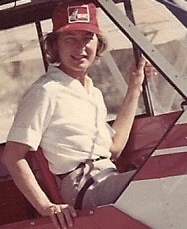 My hostess, Nancy Batson Crews and I discussed Dr. Jim Pittman’s offer to take me up for a Stearman Flight. “You should do it,” she said. I sensed an importance to her that I do this—for myself, yes, but also for her and for Dr. Jim.
My hostess, Nancy Batson Crews and I discussed Dr. Jim Pittman’s offer to take me up for a Stearman Flight. “You should do it,” she said. I sensed an importance to her that I do this—for myself, yes, but also for her and for Dr. Jim.
Friday, after the WAFS Reunion, Nancy took Teresa James and me for a ride. She pointed out her property where she hoped, someday, to build a house. She showed us where there was room for a grass landing strip across the road. The pride in her land, her accomplishments with it, and her hope for the future radiated from her descriptions
We put Teresa on her plane Saturday morning, stopped for lunch at Nancy’s favorite barbecue joint and headed to Pell City airport. It was trying to rain. Dr. Jim was at his
hangar waiting for us, and there stood the blue and yellow, open cockpit Stearman. I climbed up on the lower wing, stepped down into the front seat and checked out the cockpit. Stearman Flight, here I come!
Threatening Weather … but Stearman Flight “a Go”
Dr. Jim and Nancy kept looking at the sky. The clouds were low and looked full of rain. “Let’s go check the weather station,” he said. The three of us piled into Nancy’s car and drove over to the operations building. There, the radar screen projected a rapidly-changing weather picture. He studied it for a minute, then pointed to a slightly lighter area on the screen. “We’ve got a half an hour, maybe,” he said. “You wanna fly?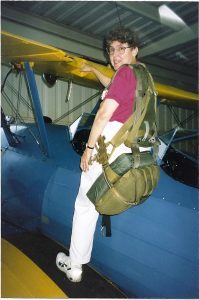
He helped me buckle into a WWII vintage parachute. It was so heavy it almost pulled me over backwards. I set my shoulders against its weight. I’m not sure I could have pulled that ripcord, but I suppose if my life depended on it I would have found the strength and leverage. I climbed into the front seat. Dr. Jim handed me earphones and helped me adjust them. “So I can talk to you,” he said. Then he helped me fasten and check the safety harness. I was in. I was ready.
“We’re Gonna Do a Roll”
We took off into a lowering sky, ceiling three hundred feet. Bare minimum. We flew out over the lake and recreation area created by TVA in the 1930s. “We’re gonna do a roll,” his voice came through my earphones.
Sarah and the parachute
The airplane began to roll over to the right, hung upside down for an instant, then rolled up the other side. Whoa! What a feeling! That was my first. We didn’t do rolls in the Cessna when I took flying lessons. Before I knew it, we were rolling to the left. Then we were right side up again. I looked down at the boats on the lake and wondered if they could possibly be having as much fun as I was.
Stearman PT-17
Are You Ready for a Loop?
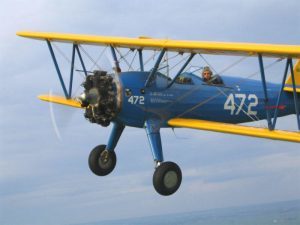
“OK, now for a loop,” Dr. Jim said, and the airplane went up, up, up, and over on its back. I was hanging upside down in my harness. Then, smooth as silk, it continued over and down and suddenly we were back to level flying. Now that one almost got me. My stomach wasn’t quite sure what had happened and didn’t believe me when I tried to tell it, “Hey, it’s OK.”
“We better head in,” I heard Dr. Jim saying, indicating the dark clouds heading in our direction. The airport was off our left wing. “OK, to help us lose altitude and get down quicker, we’re going to do a falling leaf.” The airplane began to lose altitude, not a spin, not a dive, but in a drifting motion — like a falling leaf. We entered the landing pattern on the base leg. Gently the ground closer. He turned onto final and moments later the wheels touched down. Slick as a whistle. As we sped along the runway and took the turnoff, I felt gentle rain falling on me.
We were down, and the rain had come to stay. My first aerobatic ride. Now I was beaming, if a little woozy from the loop. Nancy sat in her car reading a magazine. “How was it?” she asked. I wondered if I looked a little green around the gills, because she eyed me closely. “Fantastic,” I said. She beamed. She had been doing a lot of that.
A Phenomenal, Very Full Week!
Nancy and I headed home. It had been a full week—a phenomenal week—but now it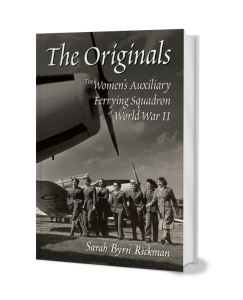 was almost over. After dinner—takeout from Cracker Barrel and a beer from her refrigerator—we sat and rehashed the whole extraordinary experience. It was truly a time neither of us would ever forget. She had made it happen. That was Nancy. She was someone who made things happen.
was almost over. After dinner—takeout from Cracker Barrel and a beer from her refrigerator—we sat and rehashed the whole extraordinary experience. It was truly a time neither of us would ever forget. She had made it happen. That was Nancy. She was someone who made things happen.
The next morning, Nancy and I said goodbye. I would begin working on The Originals, “the book” about Nancy Love and the WAFS — though at that point I hadn’t a clue how to go about it. I had just spent two years of my life sharpening my creative skills in order to write fiction. Now here I was being challenged to go back to my first calling, nonfiction, to train myself to be an historian and to write the history of twenty-eight incredible women pilots. I knew nothing about historical research and when I got home, my day job — writing and editing newsletters for two nonprofits —was waiting. But Nancy had given me an assignment.
Above: The end product of Nancy’s WAFS Reunion.
The post My First Stearman PT-17 Flight — June 1999 appeared first on Sarah Byrn Rickman.
July 10, 2019
Memories — WAFS 1999 Reunion
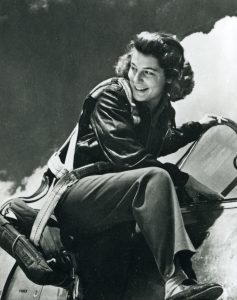 “Lake Country Estates,” the sign read. A pickup with the Stars and Bars emblazoned on the side went by going toward town. I knew I was in Alabama. I turned onto Stuart Drive.
“Lake Country Estates,” the sign read. A pickup with the Stars and Bars emblazoned on the side went by going toward town. I knew I was in Alabama. I turned onto Stuart Drive.
The house, as Nancy had described it, sat at a ninety-degree turn in the road. As I rounded the corner and pulled into the drive, two women sitting on the front porch rose from their wicker chairs, waving. One of them was Nancy. The other, I knew the minute I laid eyes on her, was Teresa James.
That was how The WAFS Reunion, June 1999, began.
Fannie Flagg Treats Us to Lunch
Nancy enlisted the help of a lot of people to bring off this gathering of Eagles. She convinced Birmingham’s newest Marriott to give her complimentary rooms for the visiting WAFS. The owners of the Irondale Café (the McMichaels family) and Fannie Flagg — Alabama author/humorist who immortalized the café in her book Fried Green Tomatoes at the Whistle Stop Café— treated the WAFS to Southern fried chicken and those legendary fried green tomatoes. The Southern Museum of Flight hosted the press conference to introduce the WAFS to Birmingham.
Monday evening, after two trips to the airport to meet arriving flights, we congregated in the hotel lounge. The six WAFS— Nancy Batson Crews, BJ Erickson London, Teresa James Martin, Gertrude Meserve Tubbs LeValley, Barbara Poole Shoemaker and Florene Miller Watson — totally captivated the serving staff and the young men and women—new employees because the hotel was newly opened—fought for the opportunity to bring them drinks and food and then hung around for conversation.
With the other five situated at the Marriott, Nancy and I called it a night and drove back to her place. Nancy was beaming.
The WAFS Meet the Birmingham Press
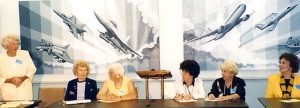 Next morning, we gathered at the Southern Museum of Flight for a tour, then got ready for the afternoon press conference. The WAFS sat behind long table and the museum director introduced them. All six told their flying-in-WWII-stories for the press and guests and they answered questions. Nancy was beaming.
Next morning, we gathered at the Southern Museum of Flight for a tour, then got ready for the afternoon press conference. The WAFS sat behind long table and the museum director introduced them. All six told their flying-in-WWII-stories for the press and guests and they answered questions. Nancy was beaming.
The Irondale Café was on Wednesday’s schedule. During lunch, Fannie Flagg called personally to wish the WAFS well for their reunion. The café —a long-time institution in the little railroad town of Irondale just east of Birmingham on I-20 — was owned, from 1932 to 1972, by Flagg’s great aunt Bess Fortenberry. When Flagg wrote her famous novel, her aunt and the cafe became famous.
Nancy’s friends, family and the aviation community turned out in force for the reception back at the museum where they met and talked with these ladies in person. Nancy, the hostess with the mostess, was elegant in a long straight white skirt open to the knee and matching top decorated with sparkly things. Nancy was not a woman who paid a lot of attention to clothes, but when she wanted to look good, she carried it off with aplomb.
Would I Like a Ride in a Stearman?
The most important acquaintance I made that afternoon was Dr. James A. Pittman. Nancy introduced us. He asked me if I had ever had a ride in a WWII trainer airplane. “No, I haven’t,” I answered. “How would you like a ride in a Stearman?” he asked.
“Oh yes,” I said.
“Have Nancy bring you out to the airport Saturday.”
Thursday morning, I had to hurry to finish my filmed interview with Poole, because she, Gertrude and B.J. [who I already had interviewed] were leaving that afternoon. Florene, Teresa and I were spending the night at Nancy’s and Nancy would take Florene to the airport at the crack of dawn Friday. Teresa and I could sleep in. She wasn’t leaving until Saturday.
Tears were shed as a museum staffer arrived to pick up the three who were flying out Thursday afternoon. They hugged me like I belonged with them and said they hoped we could all do this again. It had been wonderful. They all thanked Nancy repeatedly. She was the reason they had all come together again fifty-seven years after it all began in Wilmington, Delaware. Nancy was beaming!
When we got back to Nancy’s that evening — after dinner at Cracker Barrel — I prevailed on Florene to let me interview her. She was the only one I had not had time to film. She agreed.
Midnight Interview With Florene
Nancy and Teresa went to bed and Florene and I sat up until midnight. The audio portion of the videotape is alive with the sounds of an Alabama country summer night. The windows were open to let the night cool in. To a chorus of cicadas, other insects and croaking frogs, Florene talked about her WAFS years. With that, my interviews were complete.
Film from interviews with these incredible ladies appears in my 16-minute documentary “Five WAFS Up Close and Personal. The film features Batson, Erickson, James, Meserve and Miller — all five qualified pursuit ferry pilots. For more information on the film, please contact me — Sarah Rickman — at sarahbyrnrickman@gmail.com
My first WASP (WAFS) book was the result of this reunion. The Originals: The Women’s Auxiliary Ferrying Squadron of WWII was published two years later. Please read next week’s blog for my adventure flying with Dr. Pittman in his WWII Stearman flight trainer the Saturday following the reunion.
For Nancy’s story, please read my biography of her: Nancy Batson Crews: Alabama’s First Lady of Flight (University of Alabama Press, 2008). On Amazon, from the University of Alabama Press or the author.
The post Memories — WAFS 1999 Reunion appeared first on Sarah Byrn Rickman.
July 6, 2019
Meet Original WAFS Dorothy Fulton
Yours truly has introduced you to original WAFS Nancy Love, BJ Erickson, Teresa James and Dorothy Scott through books. How would you like to meet some more of them? Original WAFS Dorothy Fulton, for starters.
No pilot expects the propeller to drop off an airplane. But that is how nineteen-year-old Dorothy Fulton came to be hanging, without power, 2,000 feet in the air over populous Teaneck, New Jersey, her hometown.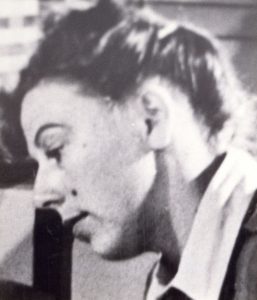
“I heard the motor ‘rev’ — that means speed up,” Dorothy told reporters. “I cut the switch. That’s drilled into us at school. Then I saw the propeller moving away from the ship. I should have been scared, but I didn’t have time. I just had time to lift the wing so the prop could get past. If I hadn’t, it would have torn the wing apart and I’d have crashed.
“I dropped the nose of my plane to keep up my flying speed — eighty miles an hour. The challenge was to stay in the air for five miles, the distance to the airport. You have to know your angles, and we learned gliding angles well at school.” Spoken like a true pilot, and Dorothy Johanna Fulton was just that — a real, honest-to-goodness pilot with the cool head under pressure to prove it.
Broken Crankshaft, Sheared Propeller
The propeller crankshaft had broken in midair and the propeller sheared off. The errant propeller ended up in a backyard on Bell Avenue. Dorothy managed to hold the airplane aloft long enough to make it back to Bendix/Teterboro Airport where she landed it without further mishap.
Dorothy planned to go looking for the propeller the next day, but the man who lived in the Bell Avenue house retrieved it and sent it over to the airport where he figured it belonged. Said Dorothy, “The only thing I was worried about was that it might have hit somebody. I’ve made plenty of forced landings before.”
Amelia Earhart flew the Atlantic in 1928 — as a passenger. Immediately she became an international heroine. In 1932, AE — to prove to herself and to the world that she could do it by herself — flew the Atlantic solo. In doing so, she inspired dreams of flight in countless young women of future generations. Dorothy —13 in 1932 — soon would soon become an aviatrix like Amelia.
A Two-Year High School Flying Course
As fate would have it, in 1933, Teaneck High School became the first high school in the country, possibly in the world, to offer students a two-year flying course that allowed them to work toward a private pilot’s license — for credit. The school’s founder and instructor was Major Arthur G. Norwood — a World War I pilot, one-time operations manager of the Bendix/Teterboro Airport, and local aviation enthusiast.
Dorothy — with a few flights in a neighbor’s small airplane under her belt — enrolled in the two-year aviation course at the beginning of her junior year at Teaneck High School. To be eligible she had to have her parents’ permission, pass the required physical, and have exceptional grades. Friends and neighbors were horrified that the Fultons would allow their eldest daughter to fly, let alone enroll in an aviation course, says Dorothy’s younger sister, Harriett “Honey” Parker. “They didn’t think such pastimes were appropriate for a young lady. But our parents let us make our own choices.”
Honey Fulton Parker is a personal friend of this author/blogger. It is she who related Dorothy’s story to me.
Seventeen-year-old Dottie Fulton soloed on March 27, 1936, was granted her amateur license on November 9, 1936, and earned her regular private pilot’s license on August 4, 1937. To secure her private license, Dottie and Major Norwood took off from Teterboro and flew to Roosevelt Field on Long Island.
Second Teaneck Girl to Graduate
Dorothy had 52 solo hours when she passed her flight test. Major Norwood told reporters who came to interview them that Miss Fulton “was right at the top of the class.” She was the second girl in Norwood’s classes to get her private license.
“I want to start courses like we have in Teaneck all over the country some day,” Dottie told the same reporters. “I want to teach kids who want to fly and who can’t afford the expensive schools to get up in the air and handle the airplane. Pretty soon planes will be as common as the auto.” And, she added, her next goal was 200 solo hours and her transport license.
Dorothy entered New York University in the fall of 1937 where she took special aviation courses. And she kept building her time in the cockpit with that transport license as her goal. She had her sights on her flight instructor rating as well as the transport rating. Both required 200 solo hours and she was closing in on that magic number.
The day she lost the propeller — July 10, 1938 — she was building her time with that goal in mind.
Original WAFS #22 in the Fold
 In September 1942, with America now embroiled in World War II, Dorothy received one of the 83 telegrams sent out by Nancy Love on September, 1942, asking her to come to New Castle Army Air Base in Wilmington, Delaware, to join the fledgling Women’s Auxiliary Ferrying Squadron (WAFS). Dorothy went, and became the 22nd woman to qualify for Nancy’s original WAFS. She had 1,966 flying hours.
In September 1942, with America now embroiled in World War II, Dorothy received one of the 83 telegrams sent out by Nancy Love on September, 1942, asking her to come to New Castle Army Air Base in Wilmington, Delaware, to join the fledgling Women’s Auxiliary Ferrying Squadron (WAFS). Dorothy went, and became the 22nd woman to qualify for Nancy’s original WAFS. She had 1,966 flying hours.
See more of Dottie’s story in my first book: The Originals. Incidentally, she is the third from the left on the cover of The Originals
THANK YOU so much for reading my blog. Hope you’ll read my many books on the WAFS and WASP of World War II. And look for more mini-bios about the Original WAFS here.
Sarah Byrn Rickman
The post Meet Original WAFS Dorothy Fulton appeared first on Sarah Byrn Rickman.
June 22, 2019
Great Booksigning at Covered Treasures Bookstore!
Covered Treasures Bookstore in Monument, Colorado, was the place to be last Thursday night, June 20. Hostess(es) with the mostest, Tommie and Paula, greeted a steady line of book shoppers and browsers.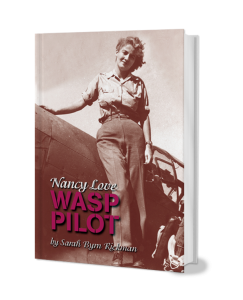
Accompanied by my grandson, Alex, I was there to sell and sign my newly released biography, Nancy Love: WASP Pilot. This book is written for today’s Young Adult reading audience — specifically today’s young women ages 10 to 14. And what a role model Nancy is!
A Pilot’s License at 16
Nancy Love earned her pilot’s license at 16. Twelve years and 1100 flight hours later, she founded and led the 28-member Women’s Auxiliary Ferrying Squadron — an integral part of the Ferrying Division, Air Transport Command in World War II. She went on to lead all 303 WASP ferry pilots for the ATC. The name Women Airforce Service Pilots or WASP replaced the WAFS name in mid 1943.
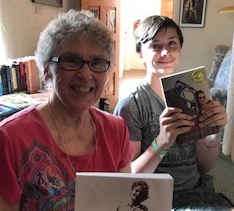 Alex’s and my customers also bought copies of my first YA-focused book, BJ Erickson: WASP Pilot. Nancy Love chose BJ to command the WASP squadron based in Long Beach, California. In 1944, ferrying P-51D Mustangs to the docks in Newark, New Jersey — for shipment to England— became THE priority task for the women pilots of BJ’s squadron. The P-51D was America’s premier single-engine fighter aircraft in WWII. It had the range to escort and protect B-17s and B-24s on bombing runs into the heart of Germany and back to England, their home base.
Alex’s and my customers also bought copies of my first YA-focused book, BJ Erickson: WASP Pilot. Nancy Love chose BJ to command the WASP squadron based in Long Beach, California. In 1944, ferrying P-51D Mustangs to the docks in Newark, New Jersey — for shipment to England— became THE priority task for the women pilots of BJ’s squadron. The P-51D was America’s premier single-engine fighter aircraft in WWII. It had the range to escort and protect B-17s and B-24s on bombing runs into the heart of Germany and back to England, their home base.
Alex and I also sold copies of my still very popular  first book, The Originals (first published 2001, second edition 2017) — the story of Nancy Love and her original WAFS ferry pilots.
first book, The Originals (first published 2001, second edition 2017) — the story of Nancy Love and her original WAFS ferry pilots.
Good to See Old Friends!
A bunch of old friends showed up. Charlie Rush for one. Charlie and I first met at the Pikes Peak Writers Conference (PPWC) in 1996. In 1999, he advocated for the my WASP manuscript, Flight from Fear. 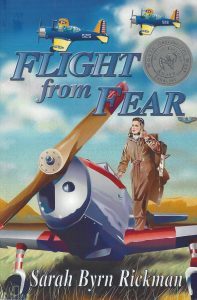 It won first place in historical fiction in PPWC’s 1999 Paul Gillette writing competition. The following year, 2000, the WASP manuscript, Flight to
It won first place in historical fiction in PPWC’s 1999 Paul Gillette writing competition. The following year, 2000, the WASP manuscript, Flight to  Destiny, made me a PPWC back-to-back winner in historical fiction.
Destiny, made me a PPWC back-to-back winner in historical fiction.
Flight from Fear (my first published novel) was a finalist in the original softcover category of Women Writing the West’s 2003 WILLA Awards, thus the silver sticker in the corner. Flight to Destiny was published in 2014. It did so well, I reprinted in 2017.
Nancy Durr, the first historian I worked with at Texas Woman’s University/ the WASP Archives — in 2000 — now lives in the Colorado Springs area. WAS I SURPRISED and delighted to see her!!! She got me started on my journey seeking and writing the WASP story!
Doris and Tom Baker of Colorado-based Filter Press — my publishers for the Love and Erickson books — were there as were three friends/fellow writers/fellow members of the Pikes Peak branch of the National League of American Pen Women, Nancy Jurka, Linda Bridges and Virginia Campbell accompanied by her husband Verne.
WASP’s Daughter Joins Us
Barbara Dixon, daughter of WASP Ann Holaday (now deceased but who used to summer next door to Barb in the Springs area) came. She and I gladly talked “WASP” to anyone who cared to listen and ask questions. A delightful young man named Gavin, who is a budding writer at age 11, was interested enough to listen and ask questions.
A host of new friends bought my books for the first time.
Nancy Love is well known in aviation circles, but not widely so outside of that. And that is unfortunate considering the outstanding attributes and far-sighted vision she exhibited throughout her time with the WAFS/WASP. Her promise was obvious even in her earlier years. She was active in aviation from the time she obtained her pilot’s license at 16 until she took command of the WAFS. Her skills and savvy took her places where, and to meet people who, recognized her vision of how to use trained, experienced women pilots in a wartime/military setting.
Nancy’s Legacy Lives On
Sadly, Nancy died of cancer in the mid 1970s. She was 62. At the same time, for the first time since WWII, women pilots began to climb into the cockpits of military aircraft and fly. Those women, and those who have become military pilots since, are very aware of Nancy Love, what she stood for and what, ultimately, she did for them.
WASP Iris Cummings Critchell, who flew pursuit aircraft for BJ at Long Beach, says this about her first meeting with Nancy. (See page 91 of Nancy Love: WASP Pilot.)
“That’s when I gained my appreciation for how gracefully she handled people and situations — quietly and wisely. For just a few moments, I was privileged to see her open up a bit and smile and speak warmly about flying, ferrying, and subsequently, the P-38. [Nancy had just become the first woman to fly the twin-engine P-38 Lightning.] She allowed herself to show her warmth and respect for BJ to those of us present. She showed the sparkle and then returned to her cool business-like bearing which served her so well.”
Again, my thanks to Tommie and Paula at Covered Treasures Bookstore, 105 2ndStreet in Monument, Colorado 80132.
SARAH SAYS: Thanks for reading my blog!!!
The post Great Booksigning at Covered Treasures Bookstore! appeared first on Sarah Byrn Rickman.
June 16, 2019
Book Signing: June 20, Covered Treasures Bookstore, Monument
Thursday, June 20, I return to Covered Treasures Bookstore, 105 2nd Street, in Monument, Colorado, to sign and sell my books about the women pilots who flew for the U.S. Army Air Forces in World War II.
Monument is hosting its first Art Hop of Summer 2019 from 5 to 8 that evening, and my books and I get to be part of it. Many many thanks to Tommie and Paula, my hostesses. PLEASE come see us!!!

My new release, Nancy Love: WASP Pilot makes its Colorado debut that evening. Like its predecessor in my fledgling WASP Pilot series, BJ Erickson: WASP Pilot, the Nancy Love biography is written for a young audience, roughly ages 10-14. Adults too will find Love’s story a captivating as well as inspirational read. Love was the founder and leader of the women ferry pilots — known as WASP or Women Airforce Service Pilots. During WWII, 303 of these women ferried (moved) aircraft across the U.S. to wherever they were needed.
Ferrying Fighters THE Job in 1944
However, the most important role played by the WASP ferry pilots surfaced in 1944 when they were called on to deliver powerful single-engine pursuit (fighter) aircraft to the East Coast docks at Newark, New Jersey. From there, these aircraft — critical to the battle to take Europe back from German control — were put aboard Liberty ships and sent to England. There, our male pilots stationed in England and Italy flew those fighters against the Germans, leading up to D-Day and beyond.
In 1944, the 134 pursuit (fighter)-qualified women pilots under Nancy Love’s command delivered a total of 4,038 fighter aircraft. Of those, 928 were the premier U.S. fighter, the P-51 Mustang. Nancy Love was the first woman to fly a P-51.
Sarah’s first WASP book The Originals will be available as will BJ Erickson: WASP Pilot.
Sarah Colorado Author’s League Finalist for BJ Erickson Biography
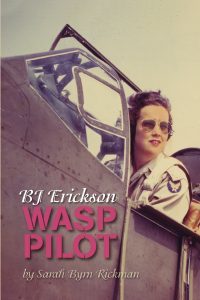 I am very pleased and proud to announce that my first Young Adult book, BJ Erickson: WASP Pilot, has earned a Finalist Award from the Colorado Authors League. The CAL awards were announced Sunday June 9, at the annual awards ceremony in Denver. This fits very nicely with BJ’s First Place win of the Sarton Women’s Book Award for Young Adult Nonfiction, given earlier this year by Story Circle Network.
I am very pleased and proud to announce that my first Young Adult book, BJ Erickson: WASP Pilot, has earned a Finalist Award from the Colorado Authors League. The CAL awards were announced Sunday June 9, at the annual awards ceremony in Denver. This fits very nicely with BJ’s First Place win of the Sarton Women’s Book Award for Young Adult Nonfiction, given earlier this year by Story Circle Network.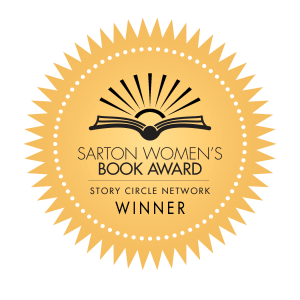
In July, I will present a program on the WASP and feature my books at the International Ninety-Nines Convention in Dayton, Ohio. The Ninety-Nines are women pilots, of which I am one. The organization was founded by Amelia Earhart and 98 other charter members on November 2, 1929. With this convention, we Ninety-Nines are celebrating 90 years of sisterhood through flying.
My D-Day Talk With AP Reporter Revisited!
If you’d like to see the article that resulted from my June 6 talk with AP reporter John Leicester, it is on Facebook. The link below should pick it up.
Thanks for reading my blog this week. Lots going on right now.
Sarah Byrn
The post Book Signing: June 20, Covered Treasures Bookstore, Monument appeared first on Sarah Byrn Rickman.
June 6, 2019
On D-Day, Let’s Also Remember WWII’s Women Pilots
D-Day, June 6, 2019 — 75 years!
This morning, I received a call from John Leicester of AP (Associated Press). He was calling from France where he was battened down in a hedgerow somewhere in Normandy. As a reporter, he was there as part of the intensive coverage — today — of the 75thanniversary of the Normandy invasion.
I was temporarily in a time warp. I, a journalist in the 1960s-’80s, was talking to a reporter on the anniversary of D-Day in 2019, giving him information on the women pilots of WWII.
My WASP friend Jean Harman had given him my name as a contact. He wanted the story of the first American women pilots to ferry Piper Cubs, known as Army Liaison planes, in 1942. Liaison aircraft were identified by the letter L followed by a number. Piper Cubs, built in Lock Haven, Pennsylvania, carried the L-4 designation.
I gladly filled him in on the first WASP squadron — then known as WAFS (Women’s Auxiliary Ferrying Squadron) — who delivered their first six Piper Cub L-4B liaison planes on October 22-23, 1942. Here is that story from Chapter 9 of my first book, THE ORIGINALS: the Women’s Auxiliary Ferrying Squadron of WWII.
From The Originals: Chapter Nine
On October 22, 1942, six WAFS were assigned to deliver six L4-B’s, or Cubs, from the Piper factory in Lock Haven, Pennsylvania, to Mitchel Field on Long Island. Nancy Love, leader of the original WAFS, appointed her second-in-command, Betty Gillies, flight leader. With Betty would be Cornelia Fort, Pat Rhonie, Helen Mary Clark, Del Scharr and Teresa James.
The six ferry pilots, anxious to shake the down from their wings and fly for real, boarded a Boeing twin-engine transport for the short flight to Lock Haven. The pilot was none other than their commanding officer, Colonel Robert Baker. “Black Bob,” as they called him because of his black mustache, had taken pity on them. He decided to send them off for their first trip by flying them to Lock Haven. This was far better than the six having to spend four hours in a Pullman car then rising at five in the morning to get off the train in Lock Haven.
Even though the Piper factory employed numerous women, the arrival of women ferry pilots was a big deal. According to Teresa, “necks stretched and eyes popped. They couldn’t have stared any more had we been freaks from the circus side show.”
‘Clark had never flown such a light ship’
The six pre-flighted their ships, climbed in and prepared to take off. A twenty-five-mile-an-hour wind was blowing from the west, promising them a hefty tail wind all the way to Long Island. “Those little four-cylinder go-carts actually leaped into the air,” Teresa recalled. “Clark had never flown such a light ship and we laughed when she said later, ‘Jeepers, I just couldn’t keep the thing on the ground.’”
They headed east, but ran out of daylight. They RONed (remained overnight) at a hotel in Allentown, Pennsylvania.
As per Betty’s orders, they were up at sunrise the next morning. Nancy Love had already warned them not to fly in formation like the men. Her instructions were, “Stay at least five hundred feet away from each other and anything else as well — and that includes clouds — and high enough over towns that you can deadstick outside them in case of emergency.” Deadstick means no power. If the engine quits, the pilot hopes to be high enough to spot an open space in which to land the little ship and then establish a glide path to get her there.
The flight leader’s job was to assign the navigator for each leg. The navigator led until she was about ten miles from the airport destination, at which time she was to throttle back so the flight leader could come forward to take them into the airport. “From then on you move in echelon formation,” Del Scharr recalls Nancy telling them. “Fly single file with each airplane a bit to the right of the one in front of it.”
Warning, Bombing Practice Ahead!
The night before, when Betty talked to her husband, Bud, he had warned her that bombing practice was planned the following day in the area where they would be flying. All flying was ordered grounded during the bombing. So Betty wired Mitchel Field operations to let them know the WAFS were coming in with deliveries that morning. She asked them to call off the guns until they could get the planes safely on the ground.
Cornelia navigated the first leg, but when they got to New Jersey, Betty, being familiar with the look of the greater New York area from the air, took the lead. “When we got over New York, I couldn’t tell Brooklyn from Coney Island in all that mas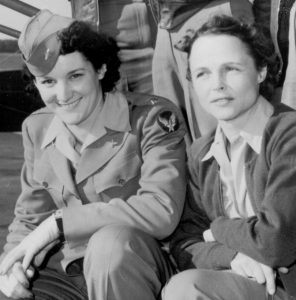 s of buildings,”Teresa says.
s of buildings,”Teresa says.
“They were expecting us at the airport and every man who could leave his post was outside to watch us land. I can just imagine the remarks. ‘Those dames! Why don’t they get smart and let the men run this Army.’ ‘Steady, men, we’ll probably see some high bouncing and modernized ground loops!’ ‘Line up, fellas, and protect the buildings.’
Teresa James and Betty Gillies
“Well, six little Cubs came in and made six perfect landings. We had made the trip in sixty-five minutes. Betty was so pleased!”
Flight leader Gillies then signed over the planes to a thunder-faced officer, who told her — in no uncertain terms — that he needed them two months ago, not now.“That’s not my problem,” she said, sweetly. “I’m merely following orders. You may speak to my commanding officer, Colonel Robert Baker at New Castle Army Air Base, or call Colonel Tunner himself at Ferrying Division headquarters.” She gave the man a big smile.
Betty Smiles Sweetly Between Clenched Teeth
Considering the man’s rudeness, and knowing Betty, the others knew that her smile was delivered around clenched teeth. About then the phone rang. It was the telegram Betty had sent asking them to call off the bombing until the Cubs were safely in. Only it was a couple of hours late being delivered.
“Betty paled when she heard the news,” Teresa recalled.
“But the Cubs were safely in, no thanks to either Western Union or Operations at Mitchel Field.”
Thus ended the WAFS’ first ferrying assignment in 1942.
THANK YOU FOR READING MY BLOG. IT WAS NEAT TALKING TO JOHN THIS MORNING.
SBR
The Originals — Second edition: 2017, Braughler Books, Paperback $22.95, on Amazon.
The post On D-Day, Let’s Also Remember WWII’s Women Pilots appeared first on Sarah Byrn Rickman.
June 1, 2019
Nancy Love: WASP Pilot — Chapter Two
It Was Not Love at First Sight
Bob Love was five-feet, eleven-inches with sandy red hair, a broad nose, and a wry sense of humor. He owned Inter City Aviation, a flight service out of East Boston.
Bob had attended Princeton and the Massachusetts Institute of Technology, but aviation so distracted him that he never finished college.
With financial help from his older sister, in 1932 he founded Inter City Aviation to offer instruction, charter flights, aerial surveying, and an unscheduled passenger service. He also sold airplanes and earned a commission from the aircraft manufacturer.
When Nancy Harkness and Henry Wilder arrived at the ICA office, Bob was away picking up an airplane.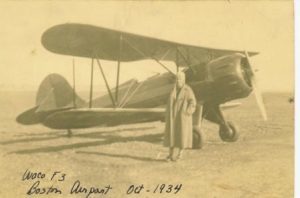
Henry ushered Nancy into Bob’s office, deposited himself in Bob’s chair and put his feet up on Bob’s desk. Nancy boostedherself onto the desk, crossed her legs, and picked up her conversation with Henry.
Enter, Bob Love
Fifteen minutes later, the door banged open and a man in grease-stained flight coveralls strode in.
A leather flight helmet and goggles dangled by their straps from one hand. He ran his other hand through his hair, mashed flat from wearing the leather helmet. His cheeks were wind-burned. Blue eyes looked out from raccoon-like white circles, the result of goggles worn when flying an open cockpit airplane.
He took in the scene in one glance. Perched on his desk in his office, obviously in deep conversation with his friend Henry Wilder, was a beautiful young woman.
She glanced up and smiled when he walked in, but she made no move to get off the desk.
He ordered his friend out of his chair and the woman off his desk.
For Nancy, a chance to be around airplanes all day everyday was what that awful stint in secretarial school and all that tomato soup had been about. Now this rude man had the nerve to order her around like some junior flunky.
Nancy Walks Out
She slid gracefully from the desk, shot him a withering look, and, mustering all her dignity, walked from the room. She slammed the door, leaving Henry to do the explaining.
Eventually, Henry came out, looking sheepish, and asked her to come back in the office. Bob Love, disagreeable as he had sounded, really did want to meet her.
Nancy desperately wanted a job in aviation. She had come here to meet this Bob Love person. Why pass up the opportunity? Just because he was testy, didn’t mean she had to be. She took a deep breath and nodded at Henry. With every ounce of dignity she could muster, she re-entered the ogre’s office.
Bob Love hired the attractive Miss Harkness. Not long after, an article appeared in New England Aviationheadlined “Woman Flier Given Praise …To Demonstrate Waco Line.” [ The aircraft manufacturer Weaver Aircraft Company of Ohio is best known by its initials — WACO.]
“She’s Not Just Somebody That Flies”
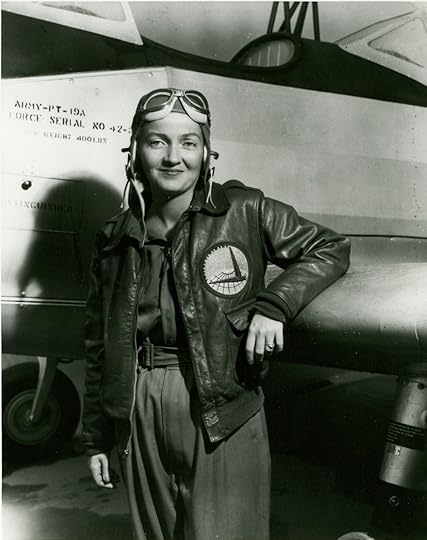 “She’s OK. She’s not just somebody that flies,” Bob Love was quoted as saying. The article went on to say that:
“She’s OK. She’s not just somebody that flies,” Bob Love was quoted as saying. The article went on to say that:
Miss Harkness is a transport pilot and in the future will demonstrate the Waco line of airplanes to prospective customers. 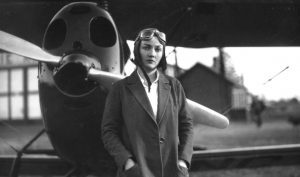 She has been flying for four years. … She is quite reserved but like all pilots warms up to the topic of flying so eventually some of her past experiences come to light. … It is anticipated that when this latest employee of the ICA becomes a little better acquainted she is going to be more than busy with her gray demonstrator which by the way is the only ambulance plane in New England.
She has been flying for four years. … She is quite reserved but like all pilots warms up to the topic of flying so eventually some of her past experiences come to light. … It is anticipated that when this latest employee of the ICA becomes a little better acquainted she is going to be more than busy with her gray demonstrator which by the way is the only ambulance plane in New England.
Her job with Bob was demonstrating and selling airplanes on a commission basis. She earned money each time she sold a plane. She was also the airport “Girl Friday” or all-purpose assistant.
On September 10, an article appeared in the Houghton, Michigan, newspaper stating that pilot Robert Love of Boston, Massachusetts, and well-known local aviatrix Miss Nancy Harkness, daughter of Dr. and Mrs. R.B. Harkness, had flown into the local airport in a Waco cabin plane.
Nancy was taking Bob home to meet Mother and Daddy.
By early 1935, changes were in the air. Two well-known women pilots, Phoebe Omlie and Louise Thaden, with timely support from the world’s most famous aviatrix, Amelia Earhart,had convinced the chief of the Airport Marking and Mapping Section of the Bureau of Air Commerce that towns and cities needed to be easily identifiable from the air.
No Highways in the Sky
There were no established airways — designated highways in the sky — like we have today. Planes didn’t have radios. Getting lost was frighteningly easy, even for an experienced pilot.
Omlie’s solution was to mark off each state in sections of twenty square miles. Paint the name of the town on the roof of the most prominent building. Place markers at 15-mile intervals between towns. She and Thaden built the project from scratch. Then they hired two rising young stars among the available female flyers, Nancy Harkness of Boston and Helen MacCloskey of Pittsburgh, to share the workload.
Going to work for the well-known and respected women flyers Thaden and Omlie meant leaving Inter City Aviation and Bob, but it was a big boost for Nancy’s aviation career.
Omlie returned to her job with the Bureau of Air Commerce. Louise, Nancy, and Helen’s job was to convince towns’ leaders to hire out-of-work men to paint the signs.
Nancy’s first day at work was September 14, 1935.
Soon after, an interview with Nancy appeared in the Boston Post. She told the reporter, “I love it. It’s really useful work in the field of aviation and I get lots of chances to fly. Two other girls have similar jobs. … I have from Maine to Florida and Michigan and Ohio.”
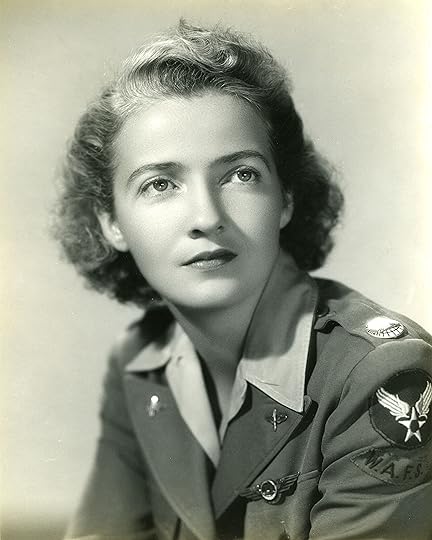

The article went on to say:
But Miss Harkness, who is barely over 20—and very pretty—can smile wisely to herself. For now she wears a sizable and very sparkling diamond ring on her left hand and she is engaged to the president of Inter City Airlines, Robert Love, son of a New York banker.
Nancy Love WASP Pilot from: http://FilterPressBooks.com
By Sarah Byrn Rickman
Release date: May 25, 2019
Order now and enjoy!
SBR
The post Nancy Love: WASP Pilot — Chapter Two appeared first on Sarah Byrn Rickman.
May 24, 2019
“Nancy Love: WASP Pilot” Debuts TOMORROW
 Tomorrow’s the Big Day! May 25, 2019
Tomorrow’s the Big Day! May 25, 2019Nancy Love: WASP Pilot — FilterPressBooks.com — releases officially tomorrow. Copies will be for sale at the WASP WWII Museum at Avenger Field in Sweetwater, Texas, where most of the WASP trained in 1943-44.
The occasion is WASP Homecoming, an annual event held on the very grounds where the women pilots trained. Originally known as WFTD’s (Women’s Flying Training Detachment), they lived, ate, slept, studied, and took their military pilot training at Avenger Field — all but the first two classes. Those women trained in Houston, but from then on Sweetwater was the home of the WASP.
Big Crowd Expected at Homecoming
Carol Cain, museum vice president, says a big crowd of WASP friends, families, and fans is expected — as always.
Nancy Love: WASP Pilot copies will be for sale in the Author’s Corner, as will several of my other WASP books: The Originals, BJ Erickson: WASP Pilot (my first young adult WASP biography) and the award-winning novel Flight to Destiny — the fictionalized version of the story of the Original WAFS. I’ve signed all of them!
Look for the poster featuring my books! Come see us. Kimberly Johnson and Shelia Bickle from the Texas Woman’s University Library / the WASP Archives will be holding down the fort in my absence. At the last minute, I am unable to make the trip.
Look for My Documentary: “Five WAFS Up Close and Personal”
Be on the lookout, too, for my WASP documentary, Five WAFS Up Close and Personal. Carol plans to have a loop running showing my exclusive film featuring five of the Original WAFS who flew for Nancy Love in the Ferry Command in WWII. I personally interviewed Nancy Batson, BJ Erickson, Teresa James, Gertrude Meserve and Florene Miller in 1999 and filmed the interviews. Remarkable women all!!!
Now, please watch and enjoy the newly released video promo for Nancy Love: WASP Pilot . You’re gonna love it!!!
The post “Nancy Love: WASP Pilot” Debuts TOMORROW appeared first on Sarah Byrn Rickman.
May 17, 2019
Nancy Love Breaks Military Barriers for Women Pilots
Nancy Harkness Love broke the military gender barrier when she led 303 civilian women pilots for the Army Air Forces’ (AAF) Ferrying Division in World War II. President Harry Truman awarded her the prestigious Air Medal for her job well done.
“Ferrying” means to fly the aircraft — not passengers or cargo — from one place to another
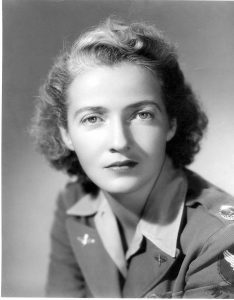
Love’s success, and that of the women who flew for her, began with the December 1941 decisions the U.S. military was forced to make after Pearl Harbor. We, as a nation, were not prepared for war. We lacked ships, aircraft, tanks, munitions — men. Case-in-point, we had too few pilots.
Love recognized the pilot shortage. She sold Ferrying Division Commander Colonel William H. Tunner on using experienced women pilots to pick up small training aircraft from the factories where they were built and deliver those trainers to flight schools. There, future male combat pilots would learn how to fly “the Army way.”
First WAFS Requirement: 500 Flying Hours
The first women Love recruited for the Women’s Auxiliary Ferrying Squadron (WAFS) had a minimum of 500 flight hours. Most had more — including a 35-year-old flight instructor and mother of three with 3500 hours [Lenore McElroy], and a 23-year-old barnstormer with 2900 [Evelyn Sharp]. Every woman pilot who could deliver an aircraft freed a male pilot to be assigned to — you guessed it — a more important job.
The women didn’t care. They wanted to fly. America was at war. Patriots to the core, they wanted to fly for their country.
Jacqueline Cochran, another woman pilot whose goal was to command a women’s air force, sold AAF Commanding General “Hap” Arnold on training women pilots to do what she called the Army’s “dishwashing” jobs. Jobs the men really didn’t want to do. The men wanted to fly fighters and bombers. Understandable. Arnold approved the first women’s flight training school in October 1942.
The first 275 graduates of that school were sent to fly for the Ferrying Division. Throughout 1943, Love’s ever increasing ranks of women pilots delivered trainer aircraft — mostly single-engine with 175 up to 600 horsepower.
Named Director of Women Pilots in July 1943, Cochran coined the name WASP (Women Airforce Service Pilots). Love retained the leadership of the women ferry pilots, but the WAFS acronym was dropped.
By 1944, the emphasis had changed. America and its Allies were winning the war.
The crucial need now was not training planes but swift fighter aircraft called pursuits. These were complex, high-powered, single-engine, single-cockpit aircraft, (your training flight was a solo.) Desperately needed now were high-powered, long-range pursuits to escort and protect America’s four-engine B-17s and B-24s on bombing runs deep into Germany and — even more important — back to England and safety.
The Men Were Needed to Fly Bombers in Combat
By now, Tunner’s staff had learned that training men to fly pursuits was a waste of valuable transition time. The male pilots were urgently needed to fly bombers overseas.
Already, Nancy Love had flown the P-51. She was Tunner’s first woman pursuit pilot. Eight of her original WAFS has followed her lead. Tunner knew and trusted Nancy and he knew her women pilots could do the job.
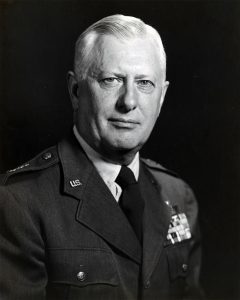 Tunner was adamant. The women would ferry pursuits.
Tunner was adamant. The women would ferry pursuits.
Fifteen of Love’s best women pilots graduated in the first two classes at the newly opened Pursuit School. Throughout 1944, up to 134 women ferried those newly built, high-powered aircraft to the docks at Newark, New Jersey. That included 926 critically needed P-51s in addition to the other pursuit aircraft. In Newark, the planes were loaded on to Liberty ships bound for England and the war.
Unlike Cochran, Love was never interested in command. She wanted to fly aircraft, not a desk. But a desk she got. She worked with the men of the Ferrying Division to prove the concept that men and women pilots should be under the same command, treated simply as pilots, judged on their capabilities, and allowed to transition into higher-performance aircraft as their skills permitted.
The airplane doesn’t “know” the sex of the pilot flying it.
Male/Female Pilots Given Equal Opportunity
Love had the full support and backing of the men she worked with in the Ferrying Division. Given her example and the record achieved by the women flying for her, Tunner saw to it that male and female pilots were given the same opportunities for advancement — an early model for what exists in today’s military.
But it wasn’t a done deal.
Sadly, on December 20, 1944, the WASP were disbanded and sent home, though the war wasn’t over. Out-of-work male flight instructors  as well as combat veterans returning home wanted those “dishwashing” jobs the women were doing. The “brass” caved. Women were banned from the cockpits of military aircraft. It would be 34 years before they were allowed back in the cockpits of military aircraft.
as well as combat veterans returning home wanted those “dishwashing” jobs the women were doing. The “brass” caved. Women were banned from the cockpits of military aircraft. It would be 34 years before they were allowed back in the cockpits of military aircraft.
The WASP’s performance — stellar and greatly appreciated by their commanding officers in WWII — was not the reason for the ban that lasted until the mid-1970s. The reason was gender politics at work. Is anyone surprised?
What exists in today’s military is what Nancy Love and the men of the Ferrying Division first achieved in WWII. Male and female pilots fly and advance based on individual skills and determination, not their gender. — Again, but it took nearly 40 years.
Now read the story of how Nancy accomplished all this in Nancy Love: WASP Pilot, by Sarah Byrn Rickman, from Filter Press, May 2019 — for Young Adult readers on up to adults.
The post Nancy Love Breaks Military Barriers for Women Pilots appeared first on Sarah Byrn Rickman.
May 10, 2019
Writing for Young Adults
From Sarah Byrn Rickman:
My publisher, Filter Press, wishes to announce the publication of my second WASP biography for Young Adults.
“May 11, 2019, Palmer Lake, Colorado— Author Sarah Byrn Rickman is a national authority on the Women Airforce Service Pilots (WASP) who flew for the Ferrying Division, Air Transport Command, in WWII. In her ninth book, Rickman introduces YA readers to Nancy Love, one of the super heroes of women’s aviation.
 “Nancy Harkness Love learned to fly in 1930 at age 16, when “nice young ladies” did not do such things. Flying became her life. When WWII began, Nancy was one of the few to see a role for women pilots. Women could fly small training aircraft within the United States thus releasing male pilots to fly combat or train more combat pilots. Later they would fly larger, faster aircraft.
“Nancy Harkness Love learned to fly in 1930 at age 16, when “nice young ladies” did not do such things. Flying became her life. When WWII began, Nancy was one of the few to see a role for women pilots. Women could fly small training aircraft within the United States thus releasing male pilots to fly combat or train more combat pilots. Later they would fly larger, faster aircraft.
“With the help of Colonel William H. Tunner, she brought her idea to fruition in 1942 with the establishment of the civilian Women’s Auxiliary Ferrying Squadron (WAFS). She was named WAFS leader and later supervisor for all WASP ferrying squadrons. During WWII, she flew twenty-one different aircraft, including the Army’s four-engine C-54 transport over the Himalayas from Calcutta, India to Kunming, China.
A Woman in a Man’s World
“Nancy Love was a woman in a man’s world and yet she negotiated the minefield of male egos, politics, and meddling from a rival and kept the WAFS and WASP flying the critically needed aircraft when it counted. Her persistence ultimately opened doors and knocked down glass ceilings for today’s female military pilots.”
Thanks to TRISH BECKMAN Commander, US Navy (retired) for the following:
“With publication of her new YA book, Nancy Love: WASP Pilot, Sarah enhances her well-established reputation for bringing the stories of the WASP of WWII to life. If the subject is WASP, Sarah is THE expert.”
Nancy Love: WASP Pilot. Available May 25, 2019. ISBN 978-0-86541-255-2 (pb), list price $ 12.95. Published by Filter Press, LLC, P.O. Box 95, Palmer Lake, CO 80133, www.FilterPressBooks.com.
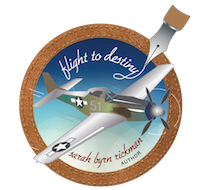
Yes, I have switched to writing for Young Adults! My WASP biographies are now aimed at today’s young women — girls ages 9 to 14. WHY — after seven successful books aimed at a general audience — would I do this?
Why Did I Switch?
I was NOT looking for another genre. In the fall of 2016, I had completed my research for my next book — the biography of original WAFS Barbara “BJ” Erickson. I was ready to start writing. With three WASP biographies already under my belt, I was looking forward to number four. Should be a relatively straight-forward task. Right? Slam dunk, piece of cake, a no brainer.
Absolutely not! Why? First, every biography is different because no two people and their experiences are alike. Each life-story brings its own set of challenges and rewards and the author/biographer is entrusted with that story. And, by rewards I mean the incredibly personal satisfaction at telling THAT story well.
How I came to make the decision to switch is a story in itself. At our Women Writing the West conference in Santa Fe the fall of 2016, two good friends — Jacque Boyd and Nancy Jurka, both writers, both retired teachers — asked me why I wasn’t telling these WASP Pilot stories for today’s young women readers? As teachers, they were uniquely aware of their students’ unmet needs. Those girls, they told me, were the audience that needed to read my books, hear these WASP stories.
Filter Press, a small Colorado publisher, took my first Y/A biography — BJ Erickson: WASP Pilot. My editor, Doris Baker, helped me adjust my writing to readers with less life experience than that of the average adult. And what I learned appears to have worked.
Thank You Story Circle Network!
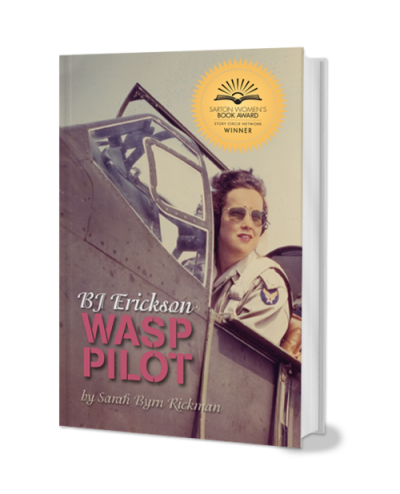 Note the gold sticker on the book cover (left). BJ Erickson: WASP Pilot has won this year’s prestigious Sarton Women’s Book Award for Young Adult Nonfiction, presented by Story Circle Network.
Note the gold sticker on the book cover (left). BJ Erickson: WASP Pilot has won this year’s prestigious Sarton Women’s Book Award for Young Adult Nonfiction, presented by Story Circle Network.
I’m ecstatic!!!
Then, with the financial backing of an aviation businessman who knew Barbara Erickson, I was able to give away copies of BJ Erickson: WASP Pilotto the 250 girls attending Girls in Aviation Day at the Women in Aviation conference in Long Beach, CA, in March. Read about this great event in my post, Women in Aviation Conference 2019.
Why write WASP biographies for young women readers?
Because what the WASP of World War II did was ground breaking for women at that time. Society’s general attitude back then was that a woman flying an airplane just wasn’t proper! At the same time, thousands of Rosie the Riveters stepped forward to woman factory production lines building aircraft and making ammunition to win the war. Women all over the U.S. stepped up and took jobs they had never held before in order to free men to go to war. It was a movement born of necessity.
Most people, young and old, still do not realize that women actually flew airplanes in World War II. So now I gladly write these remarkable women’s stories for today’s young audience. Now Nancy Love: WASP Pilot joins BJ Erickson’s biography on book shelves.
Coming May 25th from filterpressbooks.com
More about Nancy Love: WASP Pilot in next week’s blog.
Thank you for reading!
The post Writing for Young Adults appeared first on Sarah Byrn Rickman.

